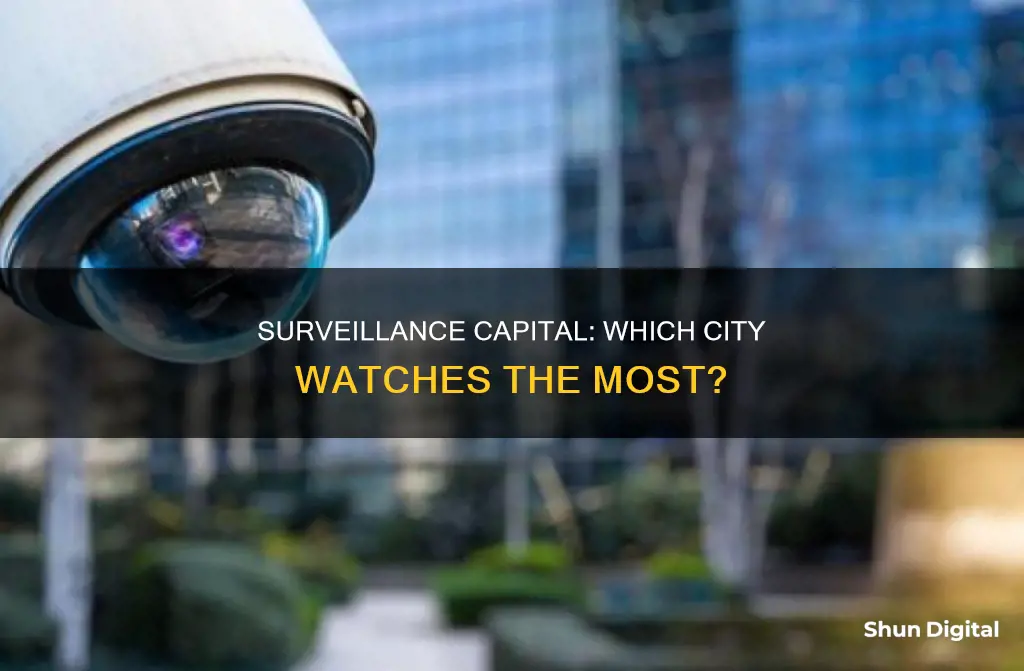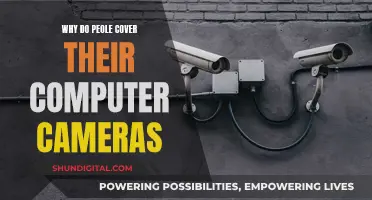
With the ever-increasing presence of surveillance, many cities around the world are under increasing amounts of surveillance. China is home to nine out of the top ten most surveilled cities, with over half (54%) of the cameras in use globally. The city of Taiyuan in China has the highest number of cameras per capita, with one camera for every eight residents. Beijing, China's capital, has the most cameras overall, with a total of 1.15 million installed. However, excluding China, the list of the world's most surveilled cities includes cities from India, Russia, Iraq, the United Kingdom, and the United States. Delhi, India, has been noted for its dense surveillance network, topping the list of cities with the most CCTV cameras per square mile.
What You'll Learn

Chinese cities have the heaviest CCTV surveillance
Chinese cities are under the heaviest CCTV surveillance in the world, with over 50% of the world's cameras located in China. While it is difficult to pinpoint the exact number of cameras in each Chinese city, estimates suggest there are around 626 million cameras in the country as a whole, which equates to around 439 cameras per 1,000 people. This means there is almost one camera for every two people in China.
China's extensive use of CCTV cameras and facial recognition technology has been widely documented. These networks enable the country's social credit program, which gives local governments an unprecedented amount of oversight over its citizens. For example, China's camera networks can be used to verify ATM withdrawals, permit access into homes, and even publicly shame people for minor offences like jaywalking.
According to a report by Comparitech, nine out of the top ten most surveilled cities in the world are in China. Taiyuan, the largest city in China's Shanxi province, tops the list with 465,255 cameras covering nearly 3.9 million people – equal to one camera for every eight residents. Beijing, China's capital city of around 20 million people, has the most cameras overall, with a total of 1.15 million installed, though fewer cameras per capita than Taiyuan.
While China's heavy surveillance may be concerning to some, it is mostly viewed as a positive development by Chinese citizens. In a 2018 survey of 2,209 citizens, 80% of respondents approved of social credit systems. One interviewee told TIME: "Having these cameras everywhere makes me feel safe".
Uniview Cameras: Where Are They Manufactured?
You may want to see also

India's cities are increasingly highly surveilled
India's cities are increasingly under heavy surveillance. According to a report by Camparitech, excluding China, the top four most surveilled cities in the world are from India: Indore, Hyderabad, Delhi, and Chennai. With a population of 3.2 million, Indore has around 63 cameras per 1,000 people, while Hyderabad, with a population of 10.5 million, has 42 cameras per 1,000 people. Delhi, with a population of 16.3 million, has 27 cameras per 1,000 people, and Chennai, with 11.5 million people, has 25 cameras per 1,000 people.
The authorities in these Indian cities have installed cameras to monitor crimes against women, children, and the elderly, as well as other illegal activities. They also use them to monitor traffic movements. The use of surveillance cameras in India is part of a global trend of increasing surveillance in cities. By the end of 2021, it was estimated that over one billion surveillance cameras had been installed worldwide.
China leads the world in CCTV surveillance, with an estimated 626 million cameras in the country, or 439 cameras per 1,000 people. Beijing, China's capital, has the highest number of cameras overall, with 1.15 million installed. However, when measured by density, Chennai in India has the highest density of CCTV cameras in the world, with 657 cameras per square kilometer.
The rise in surveillance cameras in Indian cities has raised concerns about privacy and freedom of movement. On the other hand, proponents argue that increased surveillance can lead to improved law enforcement and crime prevention, as well as a sense of community responsibility. As Indian cities continue to grow and urban resources become more limited, it remains to be seen whether the benefits of increased surveillance will outweigh the costs.
The Magic Behind Camera Glass Manufacturing
You may want to see also

London is the most surveilled city outside of China
London is one of the most heavily monitored cities in the world. The threat of terrorism is a constant concern, and CCTV helps to mitigate this by providing surveillance 365 days a year. Transport for London operates 15,576 cameras on the London Underground, and the Metropolitan Police own about 3,000 cameras attached to the outside of their buildings.
The number of CCTV cameras in London has increased due to their efficiency in helping public bodies detect and deter crime. However, research has found little correlation between the number of cameras and crime rates. While crime prevention is often a primary argument for increased CCTV surveillance, a researcher at Comparitech notes that "more cameras doesn't necessarily reduce crime rates."
London is the only non-Chinese city to feature in the top 10 most surveilled cities globally. China is home to nine out of the top 10, with Taiyuan, the largest city in Shanxi province, taking the top spot with 465,255 cameras covering nearly 3.9 million people. Beijing, China's capital, has the most cameras overall, with 1.15 million installed.
Stabilizing Your Camera: Focus Rails and Tripods
You may want to see also

Surveillance technology is controversial
In the US, for example, the Foreign Intelligence Surveillance Act (FISA) was created in 2008 to expand the power of US agencies to collect electronic "foreign intelligence information" without a warrant. Critics say that this is unconstitutional, as a lot of data from US citizens gets swept up in these searches.
Another example of controversial surveillance technology is the use of facial recognition technology. Facial recognition systems are designed to facilitate the widespread collection and mass monitoring of sensitive personal data without individualized suspicion. Facial recognition-powered cameras in public squares can be used to quickly pull up a trove of personal information—such as citizenship, age, educational status, criminal history, employment, and even political affiliation—on individual citizens, without their knowledge.
The use of facial recognition technology has also been criticized for its potential to misidentify individuals. A landmark study released by the National Institute of Standards and Technology in 2019 found that certain algorithms were more likely to misidentify African American or Asian individuals than White males "by factors of 10 to beyond 100 times."
The advent of powerful new digital technologies that enable greater mass surveillance has raised questions about whether democratic governments will be able to maintain a balance between law enforcement imperatives and citizens' rights in the years ahead.
Fight Traffic Camera Tickets: Florida Drivers' Guide
You may want to see also

There's little correlation between more cameras and less crime
The city with the most surveillance cameras is Beijing, China, with 1.15 million cameras installed. China also has nine out of the top ten most surveilled cities globally and over half (54%) of the cameras in use worldwide.
While crime prevention is often an argument for increased CCTV surveillance, there is little correlation between more cameras and less crime. Rebecca Moody, a researcher with Comparitech, states that "a higher number of cameras just barely correlates with a lower crime index. Broadly speaking, more cameras don't necessarily reduce crime rates."
This is supported by a study in Montevideo, Uruguay, which found a 20% reduction in crime in areas with police-monitored cameras, with no evidence of a displacement effect. However, the effect of surveillance cameras on crime is ambiguous, and it is unclear whether cameras reduce crime or simply relocate criminal activity.
While surveillance cameras can be effective in specific cases, such as a 50% drop in crime in Orange County, New Jersey, the overall impact on crime rates is not consistent. The use of facial recognition technology is also growing, raising concerns about privacy and potential abuse.
In summary, while more cameras may provide a sense of security and help in certain situations, there is little evidence to support a direct correlation between increased surveillance and reduced crime rates.
Troubleshooting Camera Focus: Red Alert!
You may want to see also
Frequently asked questions
While it is difficult to pinpoint the exact number of cameras in Chinese cities, China is home to nine out of the top ten most surveilled cities. Taiyuan, in the Shanxi province, has the highest number of cameras per capita, with one camera for every eight residents. Beijing, China's capital, has the most cameras overall, with 1.15 million installed.
The impact of surveillance cameras on crime rates is debated. While some argue that cameras can help prevent crime, studies have found little correlation between the number of cameras and crime rates.
London is the only city outside of China to feature in the top ten. It has 627,727 cameras for a population of 9.3 million, equal to one camera for every 14 residents.
The use of surveillance cameras is controversial, with opponents raising concerns about potential violations of privacy rights and the use of surveillance as a tool of public control. Additionally, the lack of data protection and invasive government use of facial recognition technology in some countries have been flagged as issues.







